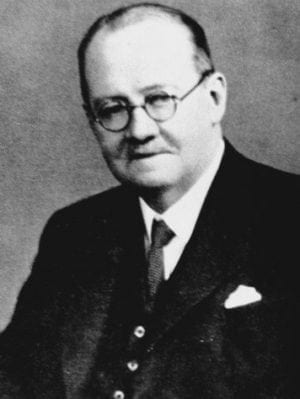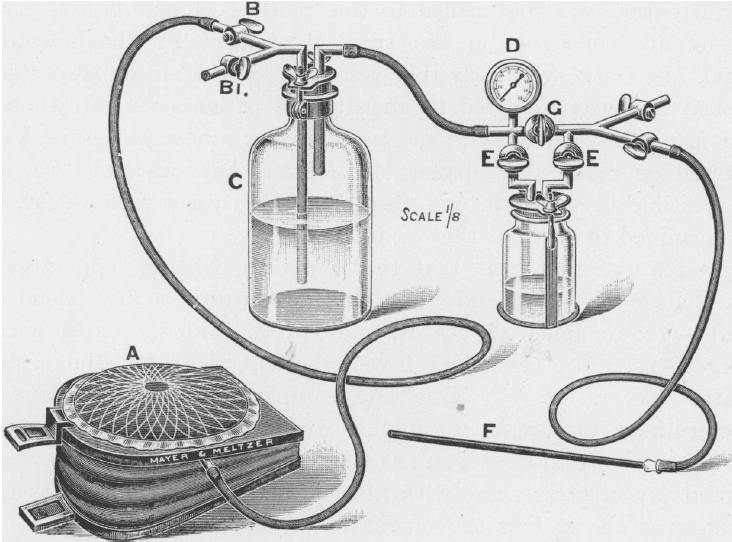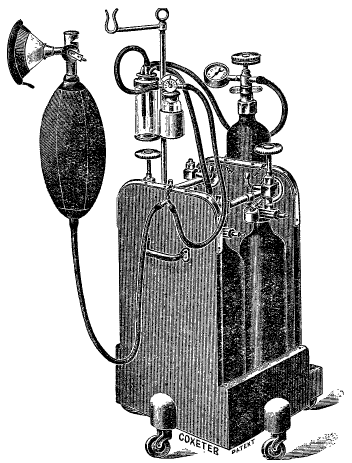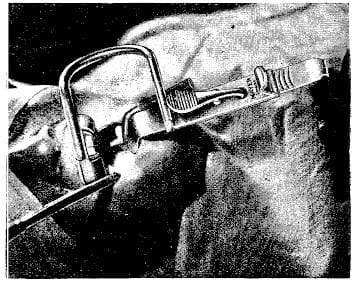Henry Edmund Gaskin Boyle
Henry Edmund Gaskin Boyle (1875-1941) was a Barbadian/British anaesthetist.
…not Robert Boyle (1627-1691) of Boyle’s law
Boyle worked at St Bartholemew’s hospital throughout his career, eventually retiring as a consulting anaesthetist in 1939. During World War I he worked with the Royal Army Medical Corps, caring for wounded soldiers in various hospitals in London, his work was recognised with an OBE.
Boyle was a pioneer in the development of anaesthetic administration. In 1916 he convinced the hospital to import the first Gwathmey nitrous oxide-oxygen-ether machine from America. Frustrated with how unreliable and prone to defects it was, he developed his own continuous flow machine with help from ideas from Geoffrey Marshall (1887-1982). He later introduced the Davis gag for dissection tonsillectomy which later became known as the Boyle-Davis gag (which is still used today). He played a key role in the development of endotracheal anaesthesia and greatly improved the anaesthesia of midwifery.
Boyle was a popular figure among colleagues and students, fondly known as ‘cocky’ Boyle. He was a keen cricketer and lifelong fan of the Barts rugby club. Since 2000 the Anaesthetics department at St Bartholomew’s hospital has been named Boyle department of anaesthesia.
Biography
- Born on April 2, 1875 in Porey Springs, Barbados; the only child of sugar plantar Henry Boyle and his Wife Elizabeth
- Educated at Harrison College, Bridgetown Barbados
- 1894 – moved to England
- 1901 – MRCS LRCP, St Bartholomew’s Hospital, London; president of the Abernethian society
- 1902 – Brief stint as a casualty officer in Bristol Royal Infirmary; then junior resident assistant anaesthetist in St Bartholomew’s hospital
- He worked as an anaesthetist in Carnarvon’s hospital, Queen Alexandra Hospital, Highgate and Paddington Green Children’s hospital and St Andrews hospital
- 1914 – Captain in the RAMC(T) and by 1917, he reported 1000 cases of nitrous oxide and oxygen with either ether or chloroform anaesthesia
- 1920 – OBE for his work in the RAMC caring for wounded soldiers during the war
- 1924 – President of the Anaesthetic Section of the Royal Society of Medicine
- 1939 – Retired to Godalming, Surrey
- Died on October 15, 1941
Medical Eponyms
Boyle Intratracheal ether apparatus (1912)
Apparatus that has been devised by Mr. G. E. Gask and myself for the intratracheal insufliation of ether. Air is driven from the bellows A, through hot water in the bottle c (the tap B is for air, and B I is a reserve tap for oxygen if necessary). The air then passes through E, over the surface of the ether in the smaller bottle, and so on to the gum-elastic catheter F. When it is desirable to give air without ether, E E are turned off and G is turned on.
Boyle Intratracheal ether apparatus 1912
Boyle machine (1919)
Boyle modified Gwathmey’s continuous flow apparatus as the Boyle Nitrous oxide-oxygen-ether outfit
The main points are : (1) each cylinder is provided with a fine adjustment reducing valve (the valves are so constructed that they can be fitted to any ordinary English cylinder); (2) the principle of the “sight feed ” has been adopted ; (3) there is a small spirit lamp for warming the reducing valve to the nitrous oxide cylinder; (4) a pressure gauge is attached to the oxygen cylinder; (5) a small rebreathing bag is attached, together with an ordinary 3-way stopcock and face-piece; (6) an ether bottle is connected up in the circuit; (7) the machine has been made in three sizes’
Boyle 1919
Boyle-Davis Gag (1922)
Boyle ‘imported’ the Canadian Davis mouth gag that then became known as the Boyle-Davis gag. In 1921, Boyle purchased a mouth gag modified for use in tonsillectomies and designed by S. Griffith Davis (1867-1934). Boyle published a paper on the gag in 1922 and then added a description to the third edition of his influential textbook Practical anaesthetics – subsequently the gag became better known as the Boyle, or Boyle-Davis, gag.
The gag shown by the accompanying illustration is a copy of one designed by Dr. Davis and was brought back by me from America. It combines gag and tongue retractor.
Boyle 1922
Major Publications
- Boyle HEG. Practical anaesthetics. London: H. Frowde. 1907 [2e 1911; 3e 1923]
- Boyle HEG. New inventions: Intratracheal Ether Apparatus. Lancet. 1912; 180(4657): 1520
- Boyle HEG, Gask GE. Demonstration of New Apparatus for the Intratracheal Insufflation of Ether. Proc R Soc Med. 1913; 6(Sect Anaesth): 8-11.
- Boyle HEG. Intratracheal Anaesthesia. Proc R Soc Med. 1914; 7(Sect Anaesth): 28-31.
- Boyle HEG. Experiences: In the use of nitrous oxide and oxygen with rebreathing in military surgery. Lancet. 1917; 190(4914): 667-669
- Boyle HEG. The choice of anaesthetic in severe injuries. Lancet. 1918; 191(4931): 350
- Boyle HEG. New inventions: Nitrous oxide-oxygen-ether outfit. Lancet 1919; 193(4980): 226
- Boyle HEG. New inventions: Improved Gas-Oxygen-Ether outfit. Lancet. 1922; 200(5183): 1389-1390
- Boyle HEG. New inventions: A combined gag and tongue retractor. Lancet. 1922; 200(5178): 1130-1131 [Boyle-Davis mouth gag]
- Boyle HEG. An improved anaesthetic apparatus. Lancet 1926; 207(5361): 1044
- Boyle HEG. Nitrous Oxide: History and development. Br Med J. 1934; 1(3812): 153–155.
Controversies
Sometimes difficult to find original papers. Boyle published many papers in the Lancet, under his preferred title of H. Edmund G. Boyle. This has led to the authorship being shared in many cases between two physicians…H. Edmund and G. Boyle
References
Biography
- Dickens M. Dr Henry Edmund Gaskin Boyle. Lancet. 1930; 215(5561): 715
- Wilkinson DJ. Henry Edmund Gaskin Boyle (1875–1941). International Congress Series 2002; 1242(4):269-276
- Maltby R. Notable Names in Anaesthesia. The Choir Press, 2013: 25-27
- Biography: Boyle, Henry Edmund Gaskin (1875 – 1941). Plarr’s Lives of the Fellows Online. Royal College of Surgeons of England.
- Bibliography. Boyle, Henry Edmund Gaskin. WorldCat Identities
Eponymous terms
- Bowden J, Bowden S. Part of the furniture– Part 1. The contribution of pioneering anaesthetist Henry Edmund Gaskin Boyle 1875–1941. Veterinary Nursing Journal. 2015: 30(11): 327-330
- Lamprell L, Ahluwalia S. Who has been hiding in your tonsillectomy tray? Eponymous instruments in tonsillectomy surgery. J Laryngol Otol. 2015; 129(4): 307-313
- Boyle’s gas anaesthesia apparatus. Museums Victoria
[cite]
Doctor currently working in South Wales, training in anaesthetics. Graduated Leeds University with MB ChB with BSc in microbiology in relation to medicine. Special interests in emergency medicine, critical care and anaesthetics






